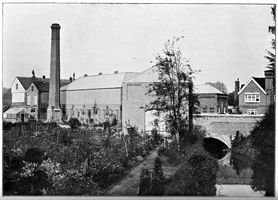
This week I gave a talk about late 19th century papermaking and William Morris. My colleagues, Nancy Bradbury and Cornelia Pearsall invited me to their Victorian Medievalism class here at Smith College. The class covers 19th century revivals and transformations of medieval literature, arts and social institutions and the remaking of the Middle Ages in the image of Victorian desires and aspirations.
When William Morris started the Kelmscott Press in the 1890s he began to commission antique handmade paper for use in his publications. Morris’ desire to revive 15th and 16th century European craft processes extended to hand papermaking. He was obsessed with the materiality, the touch, and the aesthetics of early handmade paper. He chose to work with Joseph Batchelor, a papermaker situated at the Ford Mill in Little Chart (Kent, England).
Morris had strict requirements: the paper must be linen, made with a laid mould, and sized “hard.” In addition, large quantities of paper were needed for printing each book. Batchelor had his work cut out for him as, naturally, each piece of handmade paper has its own subtle character. His quest for consistency and perfection to meet Morris’ exacting needs are documented in Volume III of the Collected Letters of William Morris, Princeton University Press, 1984.
This image shows the Ford Mill, from http://www.rttanner.co.uk/history/bachelor%20history.html
The same website gives a contemporary account of Batchelor and the Ford Mill in 1906.
